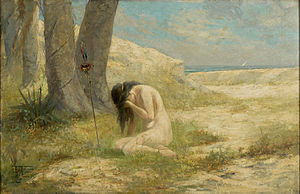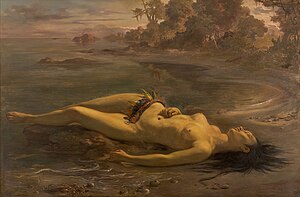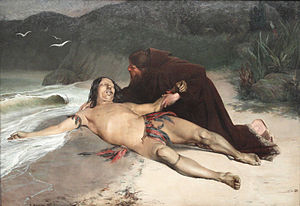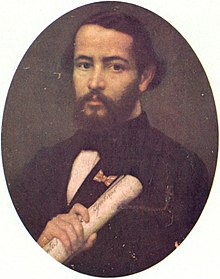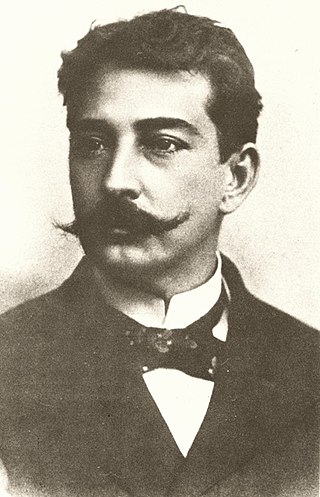
Aluísio Tancredo Gonçalves de Azevedo was a Brazilian novelist, caricaturist, diplomat, playwright and short story writer. Initially a Romantic writer, he would later adhere to the Naturalist movement. He introduced the Naturalist movement in Brazil with the novel O Mulato, in 1881. He founded and occupied the 4th chair of the Brazilian Academy of Letters from 1897 until his death in 1913.

José Martiniano de Alencar was a Brazilian lawyer, politician, orator, novelist and dramatist. He is considered to be one of the most famous and influential Brazilian Romantic novelists of the 19th century, and a major exponent of the literary tradition known as "Indianism". Sometimes he signed his works with the pen name Erasmo. He was patron of the 23rd chair of the Brazilian Academy of Letters.

José Bonifácio de Andrada e Silva was a Brazilian statesman, naturalist, mineralist, professor and poet, born in Santos, São Paulo, then part of the Portuguese Empire.

Brazilian literature is the literature written in the Portuguese language by Brazilians or in Brazil, including works written prior to the country's independence in 1822. Throughout its early years, literature from Brazil followed the literary trends of Portugal, gradually shifting to a different and authentic writing style in the course of the 19th and 20th centuries, in the search for truly Brazilian themes and use of Brazilian forms.
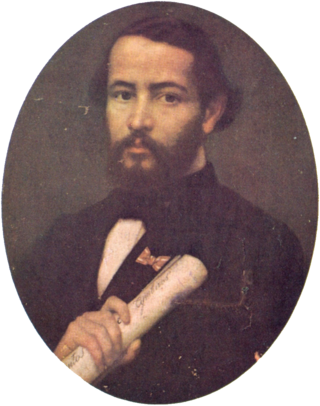
Antônio Gonçalves Dias was a Brazilian Romantic poet, playwright, ethnographer, lawyer and linguist. A major exponent of Brazilian Romanticism and of the literary tradition known as "Indianism", he is famous for writing "Canção do exílio", the short narrative poem I-Juca-Pirama, the unfinished epic Os Timbiras, and many other nationalist and patriotic poems that would award him posthumously with the title of national poet of Brazil. He was also an avid researcher of Native Brazilian languages and folklore.

Antônio Frederico de Castro Alves was a Brazilian poet and playwright famous for his abolitionist and republican poems. One of the most famous poets of the Condorist movement, he wrote classics such as Espumas Flutuantes and Hinos do Equador, which elevated him to the position of greatest among his contemporaries, as well as verses from poems such as "Os Escravos" and "A Cachoeira de Paulo Afonso", in addition to the play Gonzaga, which earned him epithets such as "O Poeta dos Escravos" and "republican poet" by Machado de Assis, or descriptions of being "a national poet, if not more, nationalist, social, human and humanitarian poet", in the words of Joaquim Nabuco, of being "the greatest Brazilian poet, lyric and epic", in the words of Afrânio Peixoto, or even of being the "walking apostle of Condorism" and "a volcanic talent, the most enraptured of all Brazilian poets", in the words of José Marques da Cruz. He was part of the romantic movement, being part of what scholars call the "third romantic generation" in Brazil.
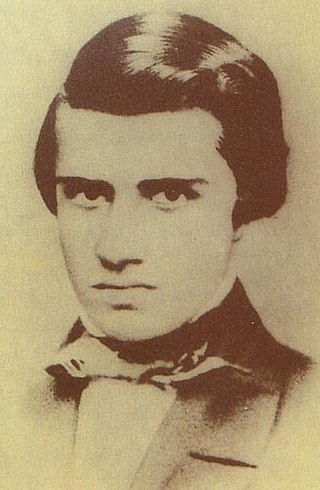
Manuel Antônio Álvares de Azevedo, affectionately called "Maneco" by his close friends, relatives and admirers, was a Brazilian Romantic poet, short story writer, playwright and essayist, considered to be one of the major exponents of Ultra-Romanticism and Gothic literature in Brazil. His works tend to play heavily with opposite notions, such as love and death, platonism and sarcasm, sentimentalism and pessimism, among others, and have a strong influence of Musset, Chateaubriand, Lamartine, Goethe and – above all – Byron.

Bernardo Joaquim da Silva Guimarães was a Brazilian poet and novelist. He is the author of the famous romances A Escrava Isaura and O Seminarista. He also introduced to Brazilian poetry the verso bestialógico, also referred to as pantagruélico — poems whose verses are very nonsensical, although very metrical. Under the verso bestialógico, he wrote polemical erotic verses, such as "O Elixir do Pajé" and "A Origem do Mênstruo". A non-erotic poem written in verso bestialógico is "Eu Vi dos Polos o Gigante Alado".
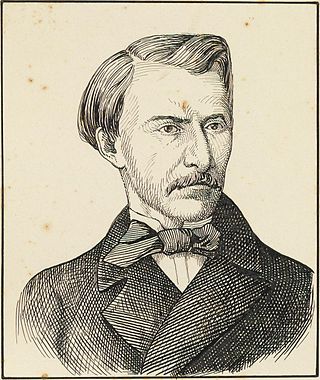
Domingos José Gonçalves de Magalhães, Viscount of Araguaia, was a Brazilian poet, playwright, physician and diplomat. He is considered the founder of Romanticism in Brazilian literature, and was a pioneer of Brazilian theatre.

Manuel José de Araújo Porto-Alegre, Baron of Santo Ângelo, was a Brazilian Romantic writer, painter, architect, diplomat and professor, considered to be one of the first Brazilian editorial cartoonists ever. He is the patron of the 32nd chair of the Brazilian Academy of Letters.
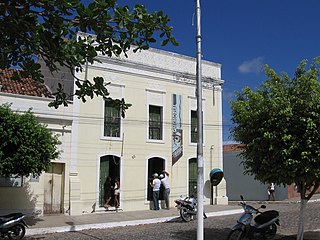
Antônio Gonçalves da Silva, popularly known as Patativa do Assaré, was a popular Brazilian oral poet, improviser of oral verse, composer, singer and guitar player. One of the main articulators of the Brazilian North-eastern oral poetry of the 20th century.

The creation of art in the geographic area now known as Brazil begins with the earliest records of its human habitation. The original inhabitants of the land, pre-Columbian Indigenous or Natives peoples, produced various forms of art; specific cultures like the Marajoara left sophisticated painted pottery. This area was colonized by Portugal in the 16th century and given the modern name of Brazil. Brazilian art is most commonly used as an umbrella term for art created in this region post Portuguese colonization.
I-Juca-Pirama is a short narrative poem by Brazilian author Gonçalves Dias. It first appeared in his 1851 poetry book Últimos Cantos, but is usually published independently of its parent tome. Written under decasyllabic and alexandrine verses, and divided in ten cantos, it is one of the most famous Indianist poems of Brazilian Romanticism.

Luís Nicolau Fagundes Varela was a Brazilian Romantic poet, adept of the "Ultra-Romanticism" movement. He is patron of the 11th chair of the Brazilian Academy of Letters.

Canção do Exílio is a poem written by the Brazilian Romantic author Gonçalves Dias in 1843, when he was in Portugal studying Law at the University of Coimbra. The poem is a famous example of the first phase of Brazilian Romanticism, which was characterized by strong nationalism and patriotism.

Teófilo Odorico Dias de Mesquita was a Brazilian poet, journalist and lawyer, nephew of the famous Romantic author Gonçalves Dias.
Maria Firmina dos Reis was a Brazilian author. She is considered Brazil's first black female novelist. In 1859, she published her first book Úrsula, which is considered the first Brazilian abolitionist novel. The book tells the story of a love triangle, in which the system of slavery is put into question.
Anhangá or Anhanga, is a figure present in the cosmovision of several native groups from Brazil and indianist literature.
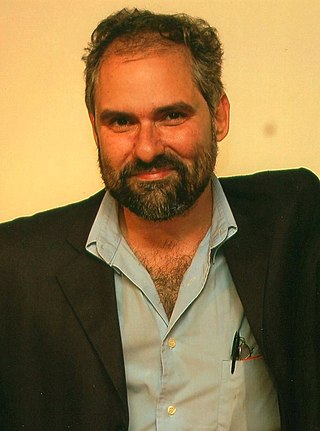
Alexei Bueno is a leading contemporary Brazilian poet. As curator, he organized more than eighty exhibitions on fine arts or on the history of literature. As editor, he published many selected or complete works of great classics of the Portuguese language, such as Camões, Fernando Pessoa, Mário de Sá-Carneiro, Almada Negreiros, Gonçalves Dias, Álvares de Azevedo, Machado de Assis, Cruz e Sousa, Olavo Bilac, Alphonsus de Guimaraens, Augusto dos Anjos and Vinicius de Moraes.

Brazilian Romantic painting was the leading artistic expression in Brazil during the latter half of the 19th century, coinciding with the Second Reign. It represented a unique evolution of the Romantic movement; it diverged significantly from its European counterpart and even the parallel Romantic movement in Brazilian literature. Characterized by a palatial and restrained aesthetic, it incorporated a strong neoclassical influence and gradually integrated elements of Realism, Symbolism, and other schools, resulting in an eclectic synthesis that dominated the Brazilian art scene until the early 20th century.
